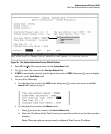
194
Enhancements in Release F.02.02
New Time Synchronization Protocol Options
Viewing the Current SNTP Configuration
This command lists both the time synchronization method (TimeP, SNTP, or None) and the SNTP
configuration, even if SNTP is not the selected time protocol.
Syntax: show sntp
For example, if you configured the switch with SNTP as the time synchronization method, then
enabled SNTP in broadcast mode with the default poll interval,
show sntp lists the following:
Figure 89. Example of SNTP Configuration When SNTP Is the Selected Time Synchronization Method
In the factory-default configuration (where TimeP is the selected time synchronization method ),
show sntp still lists the SNTP configuration even though it is not currently in use. For example:
Figure 90. Example of SNTP Configuration When SNTP Is Not the Selected Time Synchronization Method
Configuring (Enabling or Disabling) the SNTP Mode
Enabling the SNTP mode means to configure it for either broadcast or unicast mode. Remember that
to run SNTP as the switch’s time synchronization protocol, you must also select SNTP as the time
synchronization method by using the CLI
timesync command (or the Menu interface Time Sync Method
parameter).
Syntax: timesync sntp Selects SNTP as the time protocol.
sntp < broadcast | unicast > Enables the SNTP mode (below and page 195).
sntp server < ip-addr> Required only for unicast mode (page 195).
sntp poll-interval < 30 . . 720> Enabling the SNTP mode also enables the SNTP poll
interval (default: 720 seconds; page 197).
Even though, in this example, TimeP is the
current time synchronous method, the
switch maintains the SNTP configuration.


















